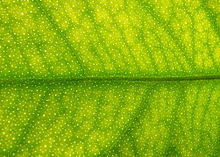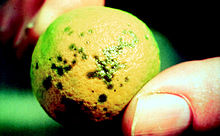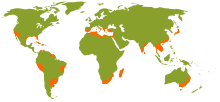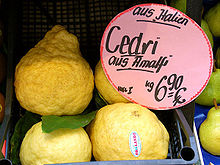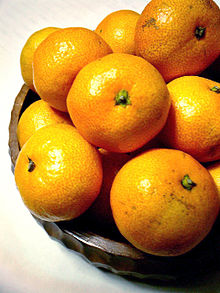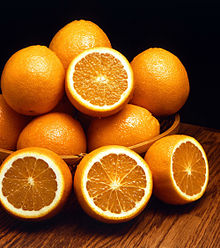
Citrus
Did you know...
This selection is made for schools by a children's charity read more. SOS Child sponsorship is cool!
| Citrus | |
|---|---|
 |
|
| Sweet orange (Citrus × sinensis cultivar) | |
| Scientific classification | |
| Kingdom: | Plantae |
| Division: | Magnoliophyta |
| Class: | Magnoliopsida |
| Subclass: | Rosidae |
| Order: | Sapindales |
| Family: | Rutaceae |
| Subfamily: | Aurantioideae |
| Tribe: | Citreae |
| Genus: | Citrus L. |
| Species and hybrids | |
|
Important species: Important hybrids: |
|
| Synonyms | |
|
Eremocitrus |
|
Citrus is a common term and genus (Citrus) of flowering plants in the rue family, Rutaceae. Citrus is believed to have originated in the part of Southeast Asia bordered by Northeastern India, Myanmar (Burma) and the Yunnan province of China. Citrus fruit has been cultivated in an ever-widening area since ancient times; the best-known examples are the oranges, lemons, grapefruit, and limes.
The generic name originated in Latin, where it specifically referred to the plant now known as Citron (C. medica). It was derived from the ancient Greek word for cedar, κέδρος (kédros). Some believe this was because Hellenistic Jews used the fruits of C. medica during Sukkot (Feast of the Tabernacles) in place of a cedar cone, while others state it was due to similarities in the smell of citrus leaves and fruit with that of cedar. Collectively, Citrus fruits and plants are also known by the Romance loanword agrumes (literally "sour fruits").
The taxonomy and systematics of the genus are complex and the precise number of natural species is unclear, as many of the named species are hybrids clonally propagated through seeds (by apomixis), and there is genetic evidence that even some wild, true-breeding species are of hybrid origin. Cultivated Citrus may be derived from as few as four ancestral species. Natural and cultivated origin hybrids include commercially important fruit such as the oranges, grapefruit, lemons, some limes, and some tangerines.
Research suggests that the closely related genus Fortunella (kumquats), and perhaps also Poncirus and the Australian Microcitrus and Eremocitrus, should be included in Citrus; most botanists now classify Microcitrus and Eremocitrus as part of the genus Citrus. Two additional genera: Triphasia and Clymenia are likewise very closely related, and bear hesperidium fruits, but are not considered part of the Citrus genus. At least one, Clymenia, will hybridize with kumquats and some limes.
Description
These plants are large shrubs or small trees, reaching 5–15 m tall, with spiny shoots and alternately arranged evergreen leaves with an entire margin. The flowers are solitary or in small corymbs, each flower 2–4 cm diameter, with five (rarely four) white petals and numerous stamens; they are often very strongly scented. The fruit is a hesperidium, a specialised berry, globose to elongated, 4–30 cm long and 4–20 cm diameter, with a leathery rind or "peel" called a pericarp. The outermost layer of the pericarp is an "exocarp" called the flavedo, commonly referred to as the zest. The middle layer of the pericarp is the mesocarp, which in citrus fruits consists of the white, spongy "albedo", or "pith". The innermost layer of the pericarp is the endocarp. The segments are also called " liths", and the space inside each lith is a locule filled with juice vesicles, or "pulp". From the endocarp, string-like "hairs" extend into the locules, which provide nourishment to the fruit as it develops.
Citrus fruits are notable for their fragrance, partly due to flavonoids and limonoids (which in turn are terpenes) contained in the rind, and most are juice-laden. The juice contains a high quantity of citric acid giving them their characteristic sharp flavour. The genus is commercially important as many species are cultivated for their fruit, which is eaten fresh, pressed for juice, or preserved in marmalades and pickles.
They are also good sources of vitamin C and flavonoids. The flavonoids include various flavanones and flavones.
Cultivation
Citrus trees hybridise very readily – depending on the pollen source, plants grown from a Persian Lime's seeds can produce fruit similar to grapefruit. Thus all commercial citrus cultivation uses trees produced by grafting the desired fruiting cultivars onto rootstocks selected for disease resistance and hardiness.
The colour of citrus fruits only develops in climates with a ( diurnal) cool winter. In tropical regions with no winter at all, citrus fruits remain green until maturity, hence the tropical "green oranges". The Persian Lime in particular is extremely sensitive to cool conditions, thus it is not usually exposed to cool enough conditions to develop a mature colour. If they are left in a cool place over winter, the fruits will change colour to yellow.
The terms "ripe" and "mature" are usually used synonymously, but they mean different things. A mature fruit is one that has completed its growth phase. Ripening is the changes that occur within the fruit after it is mature to the beginning of decay. These changes usually involve starches converting to sugars, a decrease in acids and a softening and change in the fruit's colour.
Citrus fruits are non- climacteric and respiration slowly declines and the production and release of ethylene is gradual. The fruits do not go through a ripening process in the sense that they become "tree ripe." Some fruits, for example cherries, physically mature and then continue to ripen on the tree. Other fruits, like pears, are picked when mature but before they ripen, then continue to ripen off the tree. Citrus fruits pass from immaturity to maturity to over-maturity while still on the tree. Once they are separated from the tree, they will not increase in sweetness or continue to ripen. The only way change may happen after being picked is that they will eventually start to decay.
With oranges, colour cannot be used as an indicator of ripeness because sometimes the rinds turn orange long before the oranges are ready to eat. Tasting them is the only way to know whether or not they are ready to eat.
Citrus trees are not generally frost hardy. Mandarin Oranges (C. reticulata) tend to be the hardiest of the common Citrus species and can withstand short periods down to as cold as −10 °C, but realistically temperatures not falling below −2 °C are required for successful cultivation. Tangerines, tangors and yuzu can be grown outside even in regions with more marked sub-zero degrees in winter, although this may affect fruit quality. A few hardy hybrids can withstand temperatures well below freezing, but do not produce quality fruit. Lemons can be commercially grown in cooler-summer/moderate-winter coastal Southern California, because sweetness is neither attained nor expected in retail lemon fruit. The related Trifoliate Orange (Citrus trifoliata) can survive below −20 °C; its fruit are astringent and inedible unless cooked but a few better-tasting cultivars and hybrids have been developed (see citranges).
The trees thrive in a consistently sunny, humid environment with fertile soil and adequate rainfall or irrigation. Abandoned trees in valleys may suffer, yet survive, the dry summer of Central California's Inner Coast Ranges. At any age citrus grows well enough with infrequent irrigation in partial shade, but the fruit crop is smaller. Though broadleaved, they are evergreen and do not drop leaves except when stressed. The stems of many varieties have large sharp thorns. The trees flower in the spring, and fruit is set shortly afterward. Fruit begins to ripen in fall or early winter months, depending on cultivar, and develops increasing sweetness afterward. Some cultivars of tangerines ripen by winter. Some, such as the grapefruit, may take up to eighteen months to ripen.
Major commercial citrus growing areas include southern China, the Mediterranean Basin (including southern Spain), South Africa, Australia, the southernmost United States, Mexico and parts of South America. In the United States, Florida, California, Arizona, and Texas are major producers, while smaller plantings are present in other Sun Belt states and in Hawaii.

As ornamental plants
Citrus trees grown in tubs and wintered under cover were a feature of Renaissance gardens, once glass-making technology enabled sufficient expanses of clear glass to be produced. An orangery was a feature of royal and aristocratic residences through the 17th and 18th centuries. The Orangerie at the Palace of the Louvre, 1617, inspired imitations that were not eclipsed until the development of the modern greenhouse in the 1840s. In the United States the earliest surviving orangery is at the Tayloe House, Mount Airy, Virginia. George Washington had an orangery at Mount Vernon.
Some modern hobbyists still grow dwarf citrus in containers or greenhouses in areas where it is too cold to grow it outdoors. Consistent climate, sufficient sunlight, and proper watering are crucial if the trees are to thrive and produce fruit. Compared to many of the usual "green shrubs", citrus trees better tolerate poor container care. For cooler winter areas, limes and lemons should not be grown, since they are more sensitive to winter cold than other citrus fruits. Hybrids with kumquats (× Citrofortunella) have good cold resistance.
Pests and diseases
Citrus plants are very liable to infestation by aphids, whitefly and scale insects (e.g. California red scale). Also rather important are the viral infections to which some of these ectoparasites serve as vectors such as the aphid-transmitted Citrus tristeza virus which when unchecked by proper methods of control is devastating to citrine plantations. The newest threat to citrus groves in the United States is the Asian Citrus Psyllid.
European brown snails ( Helix aspersa) can be a problem in California, though laying female Khaki Campbell and other Mallard-based ducks can be used for control.
The foliage is also used as a food plant by the larvae of Lepidoptera ( butterfly and moth) species such as the Geometridae Common Emerald (Hemithea aestivaria) and Double-striped Pug (Gymnoscelis rufifasciata), the Arctiidae Giant Leopard Moth (Hypercompe scribonia), H. eridanus, H. icasia and H. indecisa, many species in the family Papilionidae (swallowtail butterflies), and the Black-lyre Leafroller Moth ("Cnephasia" jactatana), a tortrix moth.
Since 2000, the Citrus Leafminer (Phyllocnistis citrella) has been a pest in California, boring meandering patterns through leaves.
In eastern Australia, the Bronze-orange Bug ( Musgraveia sulciventris) can be a major pest of citrus trees, particularly grapefruit. In heavy infestations it can cause flower and fruit drop and general tree stress.
The Asian citrus psyllid is an aphid-like insect that feeds on the leaves and stems of citrus trees and other citrus-like plants – but the real danger lies in that it can carry a deadly, bacterial tree disease called Huanglongbing (HLB) , also known as Citrus Greening Disease.
In June 2008, the psyllid was spotted dangerously close to California – right across the international border in Tijuana, Mexico. Only a few months later, it was detected in San Diego and Imperial counties, and has since spread to Riverside, San Bernardino, Orange, Los Angeles and Ventura counties sparking quarantines in those areas. The Asian citrus psyllid has also been intercepted coming into California in packages of fruit and plants, including citrus, ornamentals, herbs and bouquets of cut flowers, shipped from other states and countries.
Production
According to UN 2007 data, Brazil, China, the United States, Mexico, India, and Spain are the world's largest citrus-producing countries. Of these, Brazil is the world's largest producers of oranges, China produces most of the world's mandarins, India is the world's largest producer of lemons and limes, and the United States produce the most grapefruit.
In the United States, California is the largest producer of fresh oranges while Florida leads in juice production.
Uses
Culinary
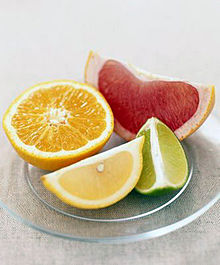
Many citrus fruits, such as oranges, tangerines, grapefruits, and clementines, are generally eaten fresh. They are typically peeled and can be easily split into segments. Grapefruit is more commonly halved and eaten out of the skin with a spoon. There are special spoons ( grapefruit spoons) with serrated tips designed for this purpose. Orange and grapefruit juices are also very popular breakfast beverages. More acidic citrus, such as lemons and limes, are generally not eaten on their own. Meyer Lemons can be eaten 'out of hand' with the fragant skin; they are both sweet and sour. Lemonade or limeade are popular beverages prepared by diluting the juices of these fruits and adding sugar. Lemons and limes are also used as garnishes or in cooked dishes. Their juice is used as an ingredient in a variety of dishes; it can commonly be found in salad dressings and squeezed over cooked meat or vegetables. A variety of flavours can be derived from different parts and treatments of citrus fruits. The rind and oil of the fruit is generally very bitter, especially when cooked, and so is often combined with sugar. The fruit pulp can vary from sweet and tart to extremely sour. Marmalade, a condiment derived from cooked orange and lemon, can be especially bitter, but is usually sweetened to cut the bitterness and produce a jam-like result. Lemon or lime is commonly used as a garnish for water, soft drinks, or cocktails. Citrus juices, rinds, or slices are used in a variety of mixed drinks. The colourful outer skin of some citrus fruits, known as zest, is used as a flavouring in cooking; the white inner portion of the peel, the pith, is usually avoided due to its bitterness. The zest of a citrus fruit, typically lemon or an orange, can also be soaked in water in a coffee filter, and drunk.
Medical
Citrus juice also has medical uses; lemon juice is used to relieve the pain of bee stings. Oranges were historically used for their high content of vitamin C, which prevents scurvy. Scurvy is caused by vitamin C deficiency, and can be prevented by having 10 milligrams of vitamin C a day. An early sign of scurvy is fatigue. If ignored, later symptoms are bleeding and bruising easily. British sailors were given a ration of citrus fruits on long voyages to prevent the onset of scurvy, hence the British nickname of Limey.
Pectin is a structural heteropolysaccharide contained in the primary cell walls of plants. The extract of it from citrus fruits is used in medicine such as Tylenol for the gelling effect of it when broken down. Limes and lemons as well as oranges and grapefruits are among the highest in this level.
After consumption, the peel is sometimes used as a facial cleanser. A peel of lemons or orange is commonly used as a means to moisten medical cannabis when stored with it.
Before the development of fermentation-based processes, lemons were the primary commercial source of citric acid.
Citrus fruit juices, such as orange, lime and lemon, may be useful for lowering the risk factors for specific types of kidney stones. Grapefruit is another fruit juice that can be used to lower blood pressure because it interferes with the metabolism of calcium channel blockers. Lemons have the highest concentration of citrate of any citrus fruit, and daily consumption of lemonade has been shown to decrease the rate of stone formation.
Citrus fruits have been observed to be used by Capuchin (Cebus capucinus) monkeys in Costa Rica as topical balms to protect against insects as well as an astringent and anti-fungal agent.
List of citrus fruits
The genus Citrus has been suggested to originate in Southeast Asia. Prior to human cultivation, it consisted of just a few species, namely:
- Citrus aurantifolia – Key Lime, Omani Lime, from India
- Citrus maxima – Pomelo (pummelo, shaddock), from the Malay Archipelago
- Citrus medica – Citron, from India
- Citrus reticulata – Mandarin orange, from China
- Citrus trifoliata – Trifoliate orange, from Korea and adjacent China (often separated as Poncirus)
- Australian limes
- Citrus australasica – Finger lime (sometimes separated in Microcitrus)
- Citrus australis – Australian round lime (sometimes separated in Microcitrus)
- Citrus glauca – Desert Lime (sometimes separated in Eremocitrus)
- and 3 other Microcitrus
- Kumquats, 4-5 species from East Asia ranging into Southeast Asia (often separated as Fortunella)
- Papedas, including
Hybrids and cultivars

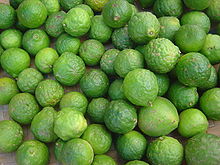
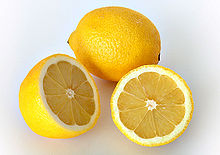
Sorted by parentage. As each is the product of (at least) two parent species, they are listed multiple times.
Citrus maxima-based
- Amanatsu, natsumikan – Citrus × natsudaidai (C. maxima × unknown)
- Cam sành (C. reticulata × C. × sinensis)
- Grapefruit – Citrus × paradisi (C. maxima × C. × sinensis)
- Imperial lemon – C. × limon × C. × paradisi
- Kinnow (C. × nobilis × C. × deliciosa)
- Kiyomi (C. sinensis × C. × unshiu)
- Lemon (probably C. maxima × C. medica)
- Minneola tangelo (C. reticulata × C. × paradisi)
- Orangelo, Chironja (C. × paradisi × C. × sinensis)
- Oroblanco, Sweetie (C. maxima × C. × paradisi)
- Sweet orange – Citrus × sinensis (probably C. maxima × C. × reticulata)
- Tangelo – Citrus × tangelo (C. reticulata × C. maxima or C. × paradisi)
- Tangor – Citrus × nobilis (C. reticulata × C. × sinensis)
- Ugli (C. reticulata × C. maxima or C. × paradisi)
Citrus medica-based
- Buddha's hand – Citrus medica var. sarcodactylus
- Citron varieties with sour pulp: Diamante citron, Florentine citron, Greek citron and Balady citron
- Citron varieties with sweet pulp: Corsican citron and Moroccan citron.
- Etrog, a group of citron cultivars (the term originally just means "citrus fruit")
- Fernandina – Citrus × limonimedica (probably C. medica × C. maxima × C. medica)
- Ponderosa lemon (probably C. medica × C. maxima × C. medica)
- Lemon (probably C. medica × C. maxima)
- Yemenite citron – a pulpless citron.
Citrus reticulata-based
- Bergamot orange – Citrus × aurantium ssp. bergamia or Citrus × bergamia
- Bitter orange, Seville Orange – Citrus × aurantium
- Blood orange – Citrus × sinensis cultivars
- Calamondin, Calamansi – Citrus reticulata × Citrus japonica
- Cam sành (C. reticulata × C. × sinensis)
- Chinotto – Citrus × aurantium var. myrtifolia or Citrus × myrtifolia
- ChungGyun – Citrus reticulata cultivar
- Clementine – Citrus × clementina
- Cleopatra Mandarin – Citrus × reshni
- Siranui – Citrus reticulata cv. 'Dekopon' (ChungGyun × Ponkan)
- Daidai – Citrus × aurantium var. daidai or Citrus × daidai
- Grapefruit – Citrus × paradisi (C. maxima × C. × sinensis)
- Hermandina – Citrus reticulata cv. 'Hermandina'
- Imperial lemon (C. maxima × C. medica × C. × paradisi)
- Kinnow, Wilking (C. × nobilis × C. × deliciosa)
- Kiyomi (C. sinensis × C. × unshiu)
- Laraha – ''C. × aurantium ssp. currassuviencis
- Mediterranean mandarin, Willow Leaf – Citrus × deliciosa
- Meyer lemon, Valley Lemon – Citrus × meyeri (C. maxima × C. medica × C. × paradisi or C. × sinensis)
- Michal mandarin – Citrus reticulata cv. 'Michal'
- Mikan, Satsuma – Citrus × unshiu
- Naartjie (C. Citrus reticulata C. Citrus nobilis)
- Nova mandarin, Clemenvilla
- Orangelo, Chironja (C. × paradisi × C. × sinensis)
- Oroblanco, Sweetie (C. maxima × C. × paradisi)
- Ponkan – Citrus reticulata cv. 'Ponkan'
- Rangpur, Lemanderin, Mandarin Lime – Citrus × limonia (C. reticulata × C. maxima × C. medica)
- Sweet orange – Citrus × sinensis (probably C. maxima × C. × reticulata)
- Tangelo – Citrus × tangelo (C. reticulata × C. maxima or C. × paradisi)
- Tangerine – Citrus × tangerina
- Tangor – Citrus × nobilis (C. reticulata × C. × sinensis)
- Ugli (C. reticulata × C. maxima or C. × paradisi)
- Yuzu – Citrus × junos (C. reticulata × C. × ichangensis)
Other/Unresolved
- Alemow, Colo – Citrus × macrophylla
- Djeruk limau – Citrus × amblycarpa
- Gajanimma, Carabao Lime – Citrus × pennivesiculata
- Hyuganatsu (Hyuganatsu pumelo) – Citrus tamurana
- Ichang lemon, Ichang Papeda – Citrus × ichangensis
- Imperial lemon – C. × limon × C. × paradisi
- Iyokan, anadomikan – Citrus × iyo
- Kabosu – Citrus × sphaerocarpa
- Kaffir lime, makrut – Citrus × hystrix
- Limetta, Sweet Lemon, Sweet Lime, mosambi – Citrus × limetta
- Palestine sweet lime( fr) – Citrus × limettioides Tanaka
- Ougonkan, Citrus flaviculpus hort ex.Tanaka
- Persian lime, Tahiti Lime – Citrus × latifolia
- Pompia ("Citrus mostruosa", a nomen nudum)
- Rough lemon – Citrus × jambhiri Lush.
- Sakurajima komikan orange
- Shekwasha, Hirami Lemon, Taiwan Tangerine – Citrus × depressa
- Shonan gold – (Ougonkan)Citrus flaviculpus hort ex.Tanaka × (Imamura unshiu)Citrus unshiu Marc
- Sudachi – Citrus × sudachi
- Sunki, Suenkat – Citrus × sunki
- Tachibana orange – Citrus × tachibana (Mak.) Tanaka
- Volkamer lemon – Citrus × volkameriana
For hybrids with kumquats, see × Citrofortunella. For hybrids with the Trifoliate Orange, see citrange.



